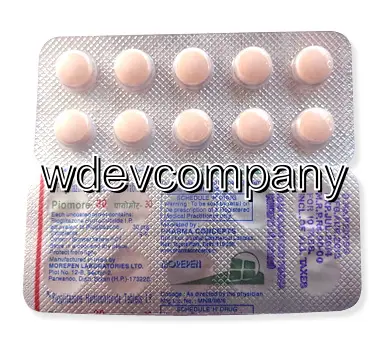| Package | Dosage | Price | Price per Dose | |
|---|---|---|---|---|
| Dosage: 15mg | ||||
| 360 pill | 15mg | $386.52 | $1.07 | |
| 180 pill | 15mg | $209.07 | $1.16 | |
| 120 pill | 15mg | $151.08 | $1.27 | |
| 90 pill | 15mg | $121.22 | $1.35 | |
| 60 pill | 15mg | $87.83 | $1.46 | |
| 30 pill | 15mg | $50.94 | $1.67 | |
| Dosage: 30mg | ||||
| 360 pill | 30mg | $664.13 | $1.84 | |
| 180 pill | 30mg | $360.17 | $2.00 | |
| 120 pill | 30mg | $261.78 | $2.18 | |
| 90 pill | 30mg | $209.07 | $2.32 | |
| 60 pill | 30mg | $149.33 | $2.48 | |
| 30 pill | 30mg | $82.56 | $2.74 | |
| 10 pill | 30mg | $31.61 | $3.07 | |

Pioglitazone Description
Overview of Pioglitazone
Pioglitazone is an oral medication primarily used to manage type 2 diabetes mellitus. As a member of the thiazolidinedione class, it helps improve insulin sensitivity in the body. People often turn to Pioglitazone when other treatments, such as metformin or insulin, do not provide sufficient blood sugar control. Its goal is to help patients maintain healthier blood glucose levels, reducing the risk of complications associated with diabetes.
Mechanism of Action
Pioglitazone works by activating peroxisome proliferator-activated receptor gamma (PPARγ). This activation enhances the transcription of insulin-responsive genes, increasing the body's sensitivity to insulin. As a result, the medication facilitates better glucose uptake by muscle and fat tissues. This mechanism helps lower blood glucose and improve metabolic function. By addressing insulin resistance, Pioglitazone plays a vital role in the comprehensive management of type 2 diabetes.
Effectiveness and Benefits
Many patients experience a significant improvement in blood sugar levels when using Pioglitazone. It can be used alone or in combination with other antidiabetic medications. One advantage is that it may also help reduce triglyceride levels and increase HDL cholesterol, contributing to cardiovascular health. Unlike some other diabetes drugs, Pioglitazone may also help preserve beta-cell function in the pancreas, supporting long-term disease management.
Potential Side Effects
While Pioglitazone offers many benefits, it can also cause side effects. Common issues include weight gain, fluid retention, and an increased risk of edema. Some users may experience headaches or muscle pain. Serious but less common risks involve liver function abnormalities, heart failure, and bone fractures. Patients with a history of heart problems or liver disease should inform their healthcare provider before starting this medication. Regular monitoring is recommended to ensure safety during treatment.
Precautions and Considerations
Before initiating Pioglitazone, a healthcare provider will typically evaluate factors such as liver health and cardiovascular risk. Patients should disclose their full medical history, including any heart issues or osteoporosis. During treatment, regular blood tests are necessary to monitor liver enzyme levels and detect early signs of adverse effects. It is crucial to follow dosage instructions carefully and report any unusual symptoms promptly. Combining Pioglitazone with a proper diet and exercise plan enhances overall effectiveness.
Summary
Pioglitazone remains an effective option for those managing type 2 diabetes, particularly for patients who need improved insulin sensitivity. Its benefits in blood sugar control and potential positive effects on lipid profiles make it a valuable component of diabetes therapy. However, awareness of its possible side effects and appropriate medical supervision are essential for safe use. With careful management, Pioglitazone can help patients achieve better glycemic control and reduce the risk of diabetes-related complications.
